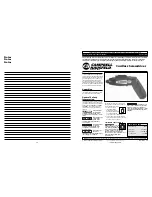
<WHITE SPACE>
is ignored except in command identifiers. e.g. '*C LS' is not equivalent to '*CLS'.
<WHITE SPACE>
is defined as character codes 00H to 20H inclusive with the exception of the NL
character (0AH).
The high bit of all characters is ignored.
The commands are case insensitive.
Command List
This section lists all commands and queries implemented in this instrument. The commands are
listed in alphabetical order within the function groups.
Note that there are no dependent parameters, coupled parameters, overlapping commands,
expression program data elements or compound command program headers; each command is
completely executed before the next command is started. All commands are sequential and the
operation complete message is generated immediately after execution in all cases.
The following nomenclature is used:
<rmt>
<RESPONSE MESSAGE TERMINATOR>
<nrf>
A number in any format. e.g. 12, 12·00, 1·2 e1 and 120 e-1 are all accepted as the
number 12. Any number, when received, is converted to the required precision
consistent with the use then rounded up to obtain the value of the command.
<nr1>
A number with no fractional part, i.e. an integer.
<nr2>
A number in fixed point format e.g. 11·52, 0·78 etc.
<n>
The number of the output or status register to which the command relates.
Note that <n>= 3 refers to the Auxiliary output.
The commands which begin with a
*
are those specified by IEEE Std. 488.2 as Common
commands. All will function when used on the RS232 interface but some are of little use.
Instrument Specific Commands
For commands specified as 'WITH VERIFY' the Operation Complete message is generated when
the parameter being adjusted reaches the required value to /-5% or +/-10 counts,
whichever is the greater. If the value fails to settle to within these limits within 5 seconds then the
Verify Timeout bit (bit 3) is set in the Standard Event Status register and the Operation Complete
message will not be generated.
When the supply is operated in LINK mode, commands which set values and ranges are applied
to outputs 1 and 2 simultaneously, regardless of the whether <n> is set to 1 or 2. When the
command requests verification then verification will be sought from both outputs before the
command is completed. Additionally the SAV<n> and RCL<n> commands operate on non-volatile
memory reserved for linked mode set-ups and <n> may be set to 1 or 2 with the same effect.
Note however that <n> is part of the command header and must be included.
V<n> <nrf>
set output <n> to <nrf> Volts
V<n>V <nrf>
set output <n> to <nrf> Volts with verify
OVP<n> <nrf>
set output <n> over voltage protection trip point to <nrf> Volts
I<n> <nrf>
set output <n> current limit to <nrf> Amps
OCP<n> <nrf>
set output <n> over current protection trip point to <nrf> Amps
V<n>?
return the set voltage of output <n>
– response is V <n> <nr2><rmt> where <nr2> is in Volts
37
















































